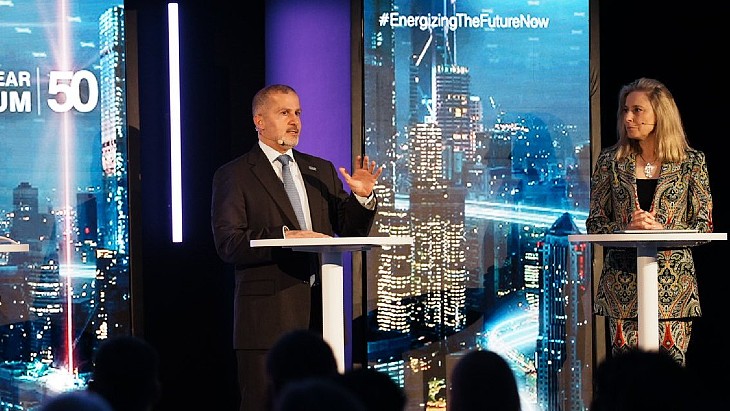The idea of constructing a prototype Prism small modular reactor at the US Department of Energy's (DoE's) Savannah River site in South Carolina is to be jointly explored by GE-Hitachi Nuclear Energy (GEH) and Savannah River Nuclear Solutions (SRNS).
As part of a proposed demonstration of small reactor technologies that could take place at Savannah River, GEH and SNRS (partnership between Fluor, Northrop Grumman and Honeywell) signed a memorandum of understanding to consider the Prism design (Power Reactor Innovative Small Module).
The MoU allows for continued discussions on the potential licensing of the Prism reactor design by the US Nuclear Regulatory Commission (NRC) and deployment of a 299 MW unit at Savannah River. However, as Savannah River is federally-owned site, it would be possible to construct a prototype unit at the site without having fully completed the NRC's usual licensing procedures. Nevertheless, the regulator would still be closely involved.
.jpg) |
| A cut-away of a power plant based on the Prism reactor (Image: GEH) |
GE with the US national laboratories had been developing Prism - a modular liquid sodium-cooled inherently-safe reactor – under the Advanced Liquid Metal Reactor/Integral Fast Reactor (ALMR/IFR) program funded by the DoE. That program was cancelled in 1994. However, the 1994 pre-application safety evaluation report for the original Prism design concluded that "no obvious impediments to licensing the Prism design had been identified."
GEH is now touting the Prism design as its Generation IV solution to closing the fuel cycle in the USA. Each Prism power block consists of two modules. The pool-type modules, below ground level, contain the complete primary system with sodium coolant.
A key attribute of Prism technology is that it generates additional electricity from recycling used nuclear fuel. The reactor's fuel - metal plutonium and depleted uranium - is obtained from the used fuel from light water reactors. Fuel stays in the Prism reactor for about six years, with one-third removed every two years. Used Prism fuel is recycled after removal of fission products.
SRNS has been actively working with industry and stakeholder groups on the development of energy security initiatives for DoE to consider at the Savannah River Site (SRS). "We think Prism can be ideally suited to support one of the SRNS initiatives, as Prism technology has the potential to address many of the nuclear fuel challenges we face today," said Caroline Reda, president and CEO of GEH.
Garry Flowers, president and CEO of SRNS, commented: "We believe that SRS is an ideal place to demonstrate the Prism reactor design as it, and other next generation, small modular reactors, are being considered for the future. Successful deployment of this reactor technology could help the United States be a leader in advanced, small modular reactor technologies and assist in achieving an important goal of the Obama administration for US energy independence."
Two potential projects
In September, SRNS signed a similar MoU with Hyperion which could lead to the construction of a prototype of Hyperion’s small fast reactor design. The agreement "envisions collaboration with the Department of Energy (DoE) on an array of technical and policy issues."
Also installed underground, the small Hyperion unit would have a thermal capacity of 75 MW. From this it should be possible to generate some 25 MWe, which Hyperion said is "enough to power a US military base, university or government complex."
The Hyperion fast reactor design uses lead bismuth coolant and uranium nitride fuel enriched to almost 20% uranium-235. It would need refuelling only every ten years and this would be done by removing the entire power module, which includes the reactor core and primary coolant loop. At Savannah River the plan is to remove these in standard nuclear transport containers to a specialist facility so that no high-level radioactive materials are stored on site.
Researched and written
by World Nuclear News




_18938.jpg)
_33584.jpg)
_82983.jpg)
_49382.jpg)





